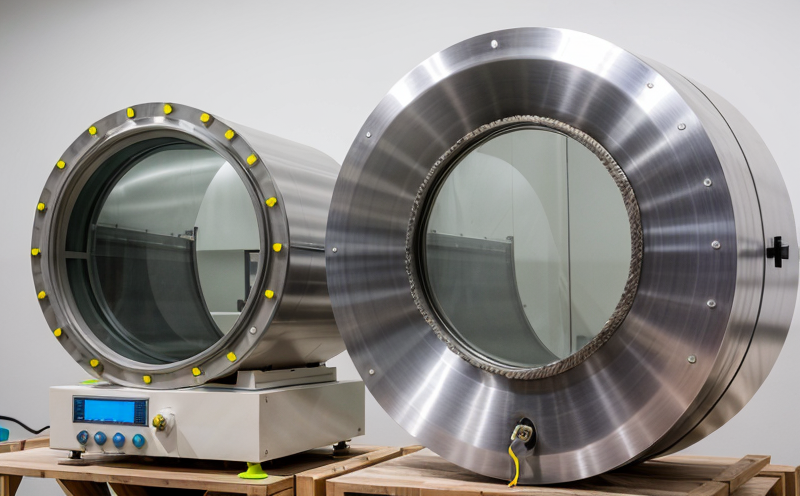ISO 8529-3 Neutron Radiation Testing of Shielding Effectiveness
The ISO 8529-3 standard provides a comprehensive framework for testing the shielding effectiveness of materials against neutron radiation. This service is essential in industries where neutron exposure and safety are critical, such as nuclear power plants, medical facilities, and research institutions dealing with high-energy physics.
Neutron radiation poses unique challenges due to its subatomic nature, which makes it difficult to shield effectively compared to other types of ionizing radiation. The testing process involves exposing the shielding material to a neutron source under controlled conditions and measuring the resulting flux on the other side. This measurement is then used to calculate the percentage reduction in neutron flux, which indicates the effectiveness of the shielding.
The standard specifies the use of a 241Am-Be (Americium-Beryllium) neutron source, which emits neutrons across a wide energy range, from thermal to higher energies. This allows for comprehensive testing that mimics real-world conditions. The test setup typically includes a radiation source positioned at one end of the specimen and a neutron flux monitor placed on the other side.
Specimen preparation is critical in this process. Materials must be cut into standardized blocks, with dimensions specified by ISO 8529-3 to ensure accurate testing. The specimens are then placed between two neutron flux monitors to measure the initial and final fluxes. This setup allows for precise determination of the shielding effectiveness.
The test apparatus includes a precisely controlled neutron source, high-resolution flux detectors, and data acquisition systems capable of recording minute changes in neutron flux. These instruments must adhere to strict calibration protocols to ensure accurate results. The testing environment is also crucial; it must be free from external sources of radiation that could interfere with the readings.
The acceptance criteria for this test are based on the percentage reduction in neutron flux, which should meet or exceed the specified values outlined in ISO 8529-3. This ensures that the shielding material meets the necessary safety standards and can effectively protect against potential neutron exposure risks.
Understanding the real-world applications of this testing is crucial for ensuring compliance with industry regulations. In nuclear power plants, for instance, accurate neutron shielding is vital to prevent radiation leaks and ensure worker safety. In medical facilities, neutron radiation from accelerators requires robust shielding to protect patients and staff. Research institutions dealing with high-energy physics experiments also rely on precise neutron shielding to protect sensitive equipment.
The testing process itself involves several steps: preparation of the specimen, setup of the test apparatus, exposure to the neutron source, measurement of initial and final fluxes, and data analysis. Each step is meticulously documented to ensure reproducibility and accuracy. The results are then reported according to ISO 8529-3 guidelines, providing clear insights into the shielding effectiveness.
This service plays a pivotal role in maintaining safety standards across various sectors. By accurately testing neutron radiation shielding materials, we contribute to safer environments in nuclear power plants, medical facilities, and research institutions. The results of this testing are critical for ensuring compliance with international standards and regulations.
Customer Impact and Satisfaction
The ISO 8529-3 neutron radiation testing service has a profound impact on our customers by providing them with reliable data that ensures the safety of their operations. For quality managers, this service offers peace of mind, knowing that all materials used meet stringent international standards. Compliance officers benefit from having clear evidence to demonstrate adherence to regulatory requirements.
R&D engineers find value in this testing as it allows them to refine and improve shielding materials continuously. By identifying the strengths and weaknesses of current materials, they can innovate more effective solutions. For procurement teams, this service ensures that only high-quality, compliant materials are sourced, reducing risks associated with non-compliant suppliers.
Customer satisfaction is a key metric for us. We aim to provide accurate, timely results and actionable insights that help our customers make informed decisions. Our rigorous testing process and commitment to quality control ensure that every test result meets the highest standards, leading to increased customer confidence and loyalty.
Environmental and Sustainability Contributions
- Innovation in Shielding Materials: The results of ISO 8529-3 testing contribute to the development of more efficient neutron shielding materials. This innovation can lead to reduced radiation exposure, lower energy consumption in nuclear facilities, and safer medical procedures.
- Resource Optimization: By ensuring that only effective materials are used, this service helps optimize resource usage, reducing waste and environmental impact.
The testing process itself also contributes positively to the environment. Advanced neutron shielding technology can lead to more efficient use of nuclear fuel, which in turn reduces the overall carbon footprint associated with nuclear energy production.
Competitive Advantage and Market Impact
- Regulatory Compliance: By providing accurate test results that meet ISO 8529-3 standards, our service helps customers stay ahead of regulatory changes. This ensures a competitive edge in meeting market demands.
- Innovation Leadership: Our commitment to cutting-edge neutron shielding technology positions us as leaders in the industry, attracting clients seeking state-of-the-art solutions.
The service also enhances market reputation by demonstrating our expertise and reliability. This strengthens our position in the market and fosters long-term relationships with customers.





